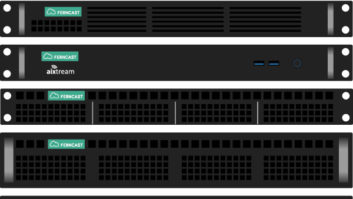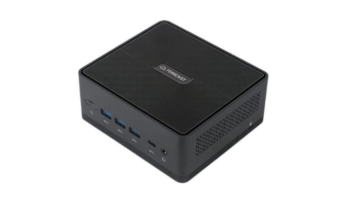MDO Develops Communicator to Bypass Hardware-Based Codecs
The Communicator software ISDN and IP audio codec is the first product in the AudioTX range from MDO UK.
Designed for such tasks as remote linking into studios, the software is suitable both studio PC and laptop use. This makes it ideal for reporting and outside broadcasts, where it is essential to get high-quality audio from a remote location to air with a minimal amount of technical equipment.
By using the software on a laptop PC with input devices such as microphones, CD or MiniDisc, we can avoid the need for a separate hardware codec and physical audio mixer.
Self-contained package
Users can handle recording, preproduction, mixing and signal transmission with a simple, self-contained package ó all that is needed is an ISDN or other digital connection.
Designed for broadcast, professional audio and telecommunications applications and running under Windows 98 or NT/2000 PCs, the Communicator can connect to ISDN audio codecs including the Musicam USA CDQ Prima, Telos Zephyr and GlenSound and Dialog4 units.
The Communicator uses a proprietary autoconnect algorithm automatically to detect the type of codec at the other end of the line and configure itself.
Both 64 kbps and 128 kbps connections are possible ó using one or two ISDN B channels ó and coding algorithms available include MPEG Layer II and Layer III in mono/stereo/joint stereo modes; G.722 as 7.5 kHz speech only and G.711 as 3.1 kHz for telephony use.
If an ADSL, DSL, cable modem or leased-line Internet connection is available, the system can make a live audio connection over the Internet.
According to the manufacturer, when using ADSL or a cable modem, a typical achievable data bit rate will be approximately 20 percent less than the maximum achievable bit rate of the connection itself in its slowest direction ó either upstream or downstream.
The actual throughput will depend on the setup of the ADSL or cable modem connection being used. However, with sufficient capacity, connection modes can include uncompressed PCM linear audio in mono or stereo modes, MPEG Layer II in mono/stereo/joint stereo modes at up to 384 kbps and MPEG Layer III in mono/stereo/joint stereo modes at up to 320 kbps.
Excellent flexibility
The Communicator can operate over Ethernet or private wide-area networks.
Using a standard PC network card or other installed networking hardware, the AudioTX Communicator can provide live audio links over IP networks. Using existing installations of hubs and routers makes the scale of a given network irrelevant.
By default, the system uses a standard IP network port, though it is possible to alter this to suit local network configuration practices.
The Communicator will run over private leased lines, using existing IP or an external device that provides Ethernet connection over the circuit concerned.
Larger organizations can use the software over ATM or other large-scale telecom networks.
Using existing networking setups in the PC on which the software is installed gives excellent flexibility. A standard network card plugged into an Ethernet connection to the ATM network is required.
Specialized ATM hardware can be employed, provided it presents an IP network connection capable of carrying TCP packets to/from the PC concerned. For such private and wide area networks, the connection modes available are the same as those available for ADSL or cable modem installations.
The Communicator is designed to work with most good-quality PC soundcards, provided that the card supports full-duplex audio and operates at 44.1 kHz or, ideally, 48 kHz.
Test circuit
Performance will be limited if the card produces electrical “crackles” or exhibits high levels of background noise during operation. At the AudioTX Web site, the manufacturer posts a list of cards recommend for use with Communicator.
The software will operate with any ISDN terminal adaptor that meets the Common ISDN Application Program Interface 2.0 specification or with a suitable Ethernet, cable modem or ADSL connection, as circumstances dictate.
Because the CAPI 2.0 standard can be somewhat loosely interpreted in some designs, MDO UK recommend sticking with one of the two biggest brands of TAs ó AVM or Eicon.
For the purposes of this review, the software was tested over ISDN circuits after installation on an 800 MHz Athalon PC with 256 MB RAM, running Windows 98SE. The PC was fitted with a PCI bus ISDN TA and a Marc 2 soundcard.
MDO UK said it tested the software on a variety of PCI, ISA, USB and PCMCIA ISDN TAs, but that because of their inherently limited data throughput capacity, serial port ISDN devices cannot be used with the software.
The minimum recommended specifications are a 300 MHz Pentium II with at least 64 MB RAM (reduced to 32 MB for a Windows 98 installation).
Clear metering
Using a standard ISDN connection at 64 and 128 kbps, MPEG Layer II connections in mono and joint-stereo were made with both the software suppliers and to the studios of KISS100 FM in London.
Tests also utilized the G.722 and G.711 modes. Operation of the AudioTX Communicator is straightforward: Simply enter the number to connect to then select the coding algorithm and the appropriate data-rate for the type of connection required.
Audio metering is done through a set of LED-style meters, which offer fast-acting peak VU-style metering coupled with PPM-style level metering.
The download software requires the purchase of an unlock code to remove the connection duration limitations of the trial mode installation. The software unlock is machine-specific; for purchasers wanting to move the software between machines, a USB or parallel port dongle-controlled version is available.
Installation was quick. The software recognized the previously installed ISDN board and soundcard and did not require a reboot before becoming operational.
MDO UK recommends that the Communicator be used on a PC running, in order of preference, under Windows 2000, Windows NT or Windows 98. The reason that Windows 2000 or NT are preferred is their ability to keep individual processes separate when multitasking.
Framing problems
The importance of this became apparent during the testing when, running Windows 98, there were problems with the “framing” of the datastream, resulting in interruptions to and distortion of the audio being transmitted and received.
The reason for this distortion was the presence of a background task running on the Windows 98 that conflicted with the resource demands of the codec software.
I solved the problem by switching off virus checkers and other System Tray tasks. On a Windows 98 machine, trying to do a live, real-time, program mix and using the Communicator software at the same time could lead to problems.
With the proviso that some engineers might feel the software is lacking in connection progress and analysis information, the AudioTX Communicator operates well on a correctly configured PC.
It will be interesting to see what other products are introduced into the range over the coming months.
For information from MDO UK, contact Mo Dutta in England at telephone: +44-121-248-0200; FAX: +44-121-248-5109; e-mail: [email protected] or visitwww.audiotx.com/ on the World Wide Web.












